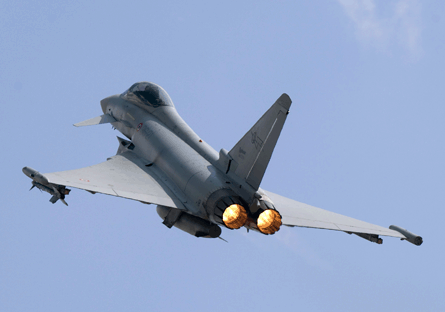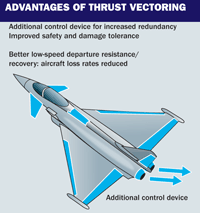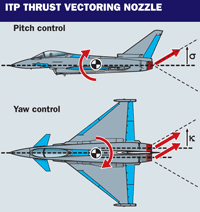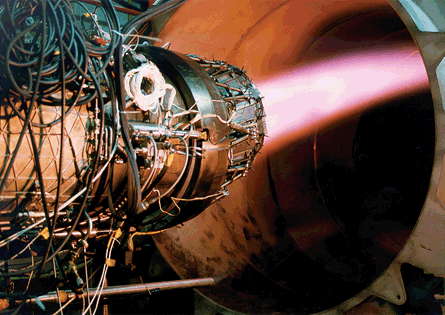Think about thrust vectoring and the image that probably springs to mind is that of an experimental fighter wowing the crowds at an air show, as the pilot pulls off seemingly impossible post-stall manoeuvres in an imaginary dogfight.
This is a pre-conception that Eurofighter Typhoon engine supplier Eurojet is attempting to dispel as it prepares to begin briefing the aircraft's current and prospective customer nations on the real-world benefits it envisages the technology could deliver to their air forces. The message is that thrust vectoring is about more than just agility.
Having demonstrated the mechanics of the concept in extensive benchtests, the engine consortium is trying to secure funds to fly its thrust vectoring nozzle (TVN) on a flight demonstrator. This, it believes, would provide data to back up its claims that TVN could reduce fuel burn on a typical Typhoon mission by up to 5%, as well as increase available thrust in supercruise by up to 7% and take-off thrust by 2%.
 |
|---|
© Eurofighter |
"Previously thrust vectoring has always been about things that will make the pilot smile," says Eurojet technical director Matt Price. "That's fantastic, but certainly in this application it's a pretty agile aircraft to begin with. While thrust vectoring still offers operational advantages, we have to look at lifecycle costs as well. The business that we're in is that we have to hit both those things together."
INTEGRATION
The proposal is to integrate a thrust vectoring capability with the twin-engined Typhoon's digital flight-control system so that it effectively functions as an additional control surface.
Eurojet partner ITP of Spain is responsible for the design of the EJ200's TVN, and has attempted to optimise the device for simplicity of operation while adding as little weight as possible (about 40kg/88lb per engine). The TVN is capable of varying the throat and exit areas independently and has a "fail-safe" mode, meaning that in the event of a loss of hydraulic pressure the nozzle closes to a position that enables the engine to deliver full dry thrust if required.
"Recognising that the convergent-divergent nozzle was one of the key competencies ITP started with, it was a very natural thing for them to look into how they could advance - from a technology point of view - their main part of the EJ200," says Price.
"Actually, relative to the existing actuation system, the design in today's nozzle lends itself quite well to not really needing huge changes to get to a thrust vectoring nozzle," he adds. "ITP I think came up with a very good solution on today's engine which means, for example, we don't need to add any more actuators to go into a thrust vectoring nozzle."
Salvador Costa Krämer, Eurofighter product manager for Tranche 3 production, Meteor integration and new business, says thrust vectoring would bring improvements to the capabilities of the Typhoon as an air-to-surface weapons delivery platform.
© Eurojet Turbo gmbh 2009 |
"There was a very clear [supersonic interceptor] mission for which the aircraft was designed, and these capabilities are already delivered to the customer," he says. "Now we are facing a different ball game, which is to adapt this weapon system platform to a number of new, different roles."
HIGH SPEED
Costa Krämer says that in terms of thrust vectoring, "most operationally significant is the speed that it gives you in supercruise, because obviously the pilots are very keen on low observability at high speed. This is really an immediate operational advantage. This number - 7% more thrust in supercruise - is quite a remarkable achievement."
The Typhoon is designed to provide the pilot with "care free" engine handling to reduce workload, and this would not change with the introduction of thrust vectoring, says Eurojet engineering director Wolfgang Sterr. The TVN has several degrees of freedom, enabling it to deliver control forces in pitch and yaw, while optimising the throat ("A8") and exit ("A9") areas to suit flight conditions, for example in supersonic cruise where a divergent configuration is required to accelerate the gas flow for increased thrust.
 |
|---|
"It is not possible [to do this] for the existing nozzle, which has a fixed schedule between A8 and A9, optimised for certain conditions only," says Sterr. "With the TVN you can reduce the fuel burn and life cycle costs as well, in certain parts of the envelope," he adds.
In the standard EJ200 a cam controls how the throat and exit areas are adjusted relative to each other, but in the TVN the exit can be ovalised and therefore varied independently from the throat, using the same actuators that are required to redirect the thrust. "You get this flexibility almost for free," says Sterr.
The result is better propulsive efficiency, which in turn could reduce fuel burn on a typical mission by "round about 3-5%".
Price adds: "At a given thrust, the engine ends up working less hard, the temperatures go down, and life goes up. That's a really strong life-cycle cost driver. We're very focused on lifecycle cost advantages and aerobatic/aerodynamic effects too. Both are attractive for future customers.
"The neat thing from a gas turbine point of view is that the rest of the engine doesn't see [the thrust vectoring] - you get it for free. It's just the nozzle. The rest of the engine isn't working any harder."
 |
|---|
The "balanced beam" design of the TVN enables weight to be minimised as there are "forces working against each other so the actuator forces are quite low", says Sterr.
Benchtesting of the TVN began in the late-1990s and was used to demonstrate more extreme degrees of vectoring than are envisaged for the Typhoon.
"This gives us a lot of confidence that the production variant that we might consider is low-risk," says Price.
Changes to the EJ200 required for thrust vectoring are limited to the introduction of additional software into the digital engine control and monitoring unit (DECMU) and a high-power hydraulic pump for the actuation system.
"Actuator demand is coming from the aircraft flight-control system, and the actuator control is within the DECMU, so obviously there must be an interface," says Robert Osterhuber, EADS Military Air Systems head of flight control and the Eurofighter partner company's project leader for Typhoon thrust vectoring. "This interface is already there, but it needs to be extended," he says.
REDUNDANCY
Osterhuber points out that an extra control surface means additional redundancy in the event of the aircraft sustaining damage during combat. For example, the Typhoon has two pitch effectors (its canards and the wing trailing edge), but the TVNs provide a third.
"If you lose one [pitch effector], you have two surfaces left to take over the required moment," he says. This function would be integrated with the flight-control system and therefore fully automated.
© Eurojet Turbo gmbh 2009 |
A further safety boost would be increased controllability at low speeds such as during the landing approach, particularly during gust conditions. This improved handling would also enhance the ability of the Typhoon to "bring back" asymmetric weapons loads, or even take-off with a single stand-off weapon such as the MBDA Storm Shadow.
Thrust vectoring could in addition be used to reduce approach speed, opening the door to a potential naval version of the Typhoon, which has attracted the attention of at least one potential export customer, according to Costa Krämer.
A spin-off of using the TVN as a control surface is that thrust vectoring can be used to trim the aircraft and "unload" the flight- control surfaces, thereby reducing drag and/or increasing lift. The conventional control surfaces are meanwhile "liberated" from their role as trim devices and can be used to enhance manoeuvrability.
In supersonic flight, even small flap deflections can cause large amounts of drag.
"If you have thrust vectoring, you can put your aerodynamic surfaces in the best position to give optimum lift and drag, because you do not need to trim the aircraft with aerodynamic surfaces," says Osterhuber.
TRIM-DRAG REDUCTION
The TVN's ability to enable the engine to produce thrust more efficiently, coupled with the trim-drag reduction, results in a "double win", says Eurojet's Price.
He says the software control laws for the TVN are "relatively simple on our side, and we've worked with Robert and his team at EADS to understand how they would work together from a control logic point of view".
EADS has system design responsibility for the Typhoon's flight-control system, while Alenia is responsible for engine integration.
The capability of the TVN would be constrained to avoid the need for structural changes to the airframe or engine, allowing it to be retrofitted to current-standard EJ200s in a "theoretically simple" way, says Price. The engines fitted to Tranche 1 Typhoons would however require a new DECMU.
Thrust vectoring could bring a range of additional benefits to the Typhoon depending on the flight regime. Below around 300kt (555km/h), where the aircraft's flight-control surfaces have limited effect due to low aerodynamic pressure, it can provide enhanced manoeuvrability. At higher speeds, the ability to modify the size and shape of the engine nozzles brings an increase in net thrust.
"There are benefits all over the place," says Eurojet's Sterr. "You can reduce your take-off distances considerably because you are able to rotate the aircraft much earlier with thrust vectoring to generate the lift. You can't generate a moment without thrust vectoring to rotate earlier."
 |
|---|
© Eurojet |
With theoretical studies and benchtests of the TVN completed, Eurojet hopes to get a two-phase flight-test programme under way. Ideally, phase one would involve equipping a twin-engined fighter such as the Typhoon with a single TVN - not integrated with the flight-control system - to validate Eurojet's computer models. The second phase would involve both engines being equipped with TVNs, and full integration with the flight-control system.
Meanwhile, EADS has equipped its Typhoon flight simulator at Manching to mimic the effects of thrust vectoring so that pilots can evaluate the potential benefits.
"We have developed flight-control laws and we have got a modified engine model," says Osterhuber. "We put these together, and we can evaluate now if pilots like it in combat scenarios."
In addition to providing "something tangible for the customer", Price says there are two elements to the simulator project. "First of all it's validating that everything works as expected in terms of the total flight-control system. We can fly missions and see what it does in terms of fuel burn, simulate what the engine is doing and validate the numbers in terms of life-cycle cost saving."
ASTONISHED PILOTS
But, he adds, "the pilot also sees how the aircraft flies with the thrust vectoring system. Some of the pilots have been quite astonished at what the aircraft can do."
Osterhuber says that some pilots have described their experiences in the simulator as "eye watering", adding: "We are nearly at the end of a feasibility study. We are now ready to take our concepts and show potential performance improvements."
Eurojet is putting together financial data with the aim of demonstrating that adoption of thrust vectoring by Eurofighter customer nations would quickly pay for itself.
"We know the benefit is there," says Price. "In terms of route to market we need to be able to quantify that and present it in the right way to the customer.
"The benefits should be able to stand on their own, even if it's a retrofit programme."
Funding to support a flight-test effort would need to come from one or more of the core nations or export customers, and/or industry.
If thrust vectoring is introduced on the Typhoon, it is likely to be part of a wider package of improvements, such as the integration of stand-off weapons or potentially the heavier "E-Scan" active electronically scanned array radar.
"There is a very obvious synergy [with the E-Scan radar] in introducing this little extra weight [for the TVN] in the rear, as then you don't need to redesign your control laws for a new centre of gravity," says Costa Krämer.
It is clear that customers will not pay for thrust-vectoring simply to enable their Typhoons to pull post-stall air show stunts, but with so many other potential benefits available, Eurojet wants to deliver the message to the customer nations in the right way.
"There's a prejudice that we have to break, and we have to make sure we do that in a robust way, and time it both in terms of the market that's out there, and in terms of the information that we can bring," says Price.
Source: Flight International



















